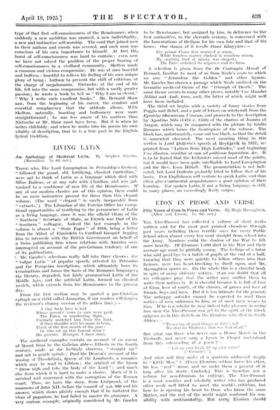LIVING LATIN
An Anthology of Medieval Latin. By Stephen Gaselee. (Macmillan. 7s. 6d. net.) THOSE who, like Lord Lumpington in Friendship's Garland, "followed -the grand, old, fortifying, classical curriculum,"
were apt to think of Latin as a language which died with Silius Italieus, or at any rate with Claudian, and was gal vanized to a semblance of new life at the Renaissance. If
any of our modern classics are of this opinion, there could be no more instructive present for them than this elegant volume. (The. word " elegant " is, surely inseparable from
extracts.") The Librarian of the Foreign Office has exceptional opportunities of testifying to the permanence of Latin as a living language, since it was the official idiom of the " Northern " Secretary of State, as French was that of his " Southern " colleague. Indeed the last example in the volume is almost a "State Paper" of 1916, being a letter from the Abbot of Eirtsiedeln to Cardinal Gasquet begging him to intercede with the British Government on behalf of a Swiss publishing firm whose relations with America were interrupted on account of the pro-German tendency of one of its publications.
Mr. Gaselee's selections really fall into three classes : the "vulgar Latin" of popular speech, attested by Petronias and the Pompeian inscriptions, which ultimately loses its terminations and forms the basis of the Romance languages the literary, degraded, but fairly grammatical Latin of the Middle Ages, and the artificial Latin, formed on classical
Models, which extends from the Renaissance to the preseat•.
day.
From the first section may be quoted a pre-Christian epitaph on a child called Januarius, if our readers will forgive" the reviewer's clumsy version of its artless lines :-
A tiny body hero is laid Whoso parents' vows in vain were paid. The Fates, in unrelenting flight, • Untimely snatched him from the light. If thou shouldst wish his name to hear, Think of the first month of the year : Or who set up this funeral stone ?
His parents. Stranger, I have done. .
The medieval examples contain an account of an ascent of Mount Sinai by the Galician abbess Etheria in the fourth Century, made, as she feelingly observes, "straight lip', and not in gentle spirals ; Paul the Deacon's account of the wooing of Theoddinda, Queen of the Lombards, a romance
which may be read in Gibbon ; the original of the hymn "Draw nigh and take the body of the Lord" ; and muchelse from which it is hard to make a choice. Much of it is satirical and concerned with the corruption of the Roman court. Thus, we have the story, from Liutprand, of the
summons of John XII. before the council of A.D. 960 and his answer, which shows plainly enough that if he imitated the
vices_ of paganism, he hadfailed to master its grammar. A very curious example, originally considered by Mr. Gaselee to be Renaissance, but assigned by him, in deference to the best authorities, to the eleventh century, is concerned with the lamentations of Oedipus for his own fate and that of his home. One stanza of it recalls Omar Khayyam :
Ere primal Chaos first received a norm,
While formless matter clashed in senseless storm, My crushing load of misery was shaped form.
A Fateu ordained its sequence and its form.
A selection is given from the De Contemplu Mundi of Bernard, familiar to most of us from Neale's cento to which we owe "Jerusalem the Golden" and other hymns. Mr. Gaselee has chosen a passage which Neale omitted on the favourite medieval theme of the "triumph of Death." The same theme occurs in many other pieces, notably Cur Mundus Milital and Audi, terra, audi, the latter of which might well have been included.
. The third set begins with a variety of funny stories from Poggio and Bebel, and a pair of letters on witchcraft from the Epistotae Obscurorum L'irorunt, and proceeds to the description by Agostino Nifo (1-473--e. 1550) of the charms of Joanna of Aragon, which may be compared with the picture by Giulio Romano which forms the frontispiece of the volume. The block has, unfortunately, come out too black, so that the detail is somewhat obscured. The most amusing thing in this section is Lord Dufferin's speech at Reykjavik in 1857, reprinted from "Letters from high Latitudes," and beginning Viri illustres, insolitus td sum ad publicum loquendum, &c. It is to be feared that the Icelanders missed most of the points, but it would have been quite intelligible to Lord Lumpington and the Rev. Esau Ilittall. The pronunciation is not indicated, but Lord Duffcrin probably tried to follow that of his hosts. Few Englishmen will venture to speak Latin, and thus often give Continental acquaintances a poor opinion of their learning. For spoken Latin, if not a hying language, is still, in many places, an exceedingly lively corpse.










































 Previous page
Previous page